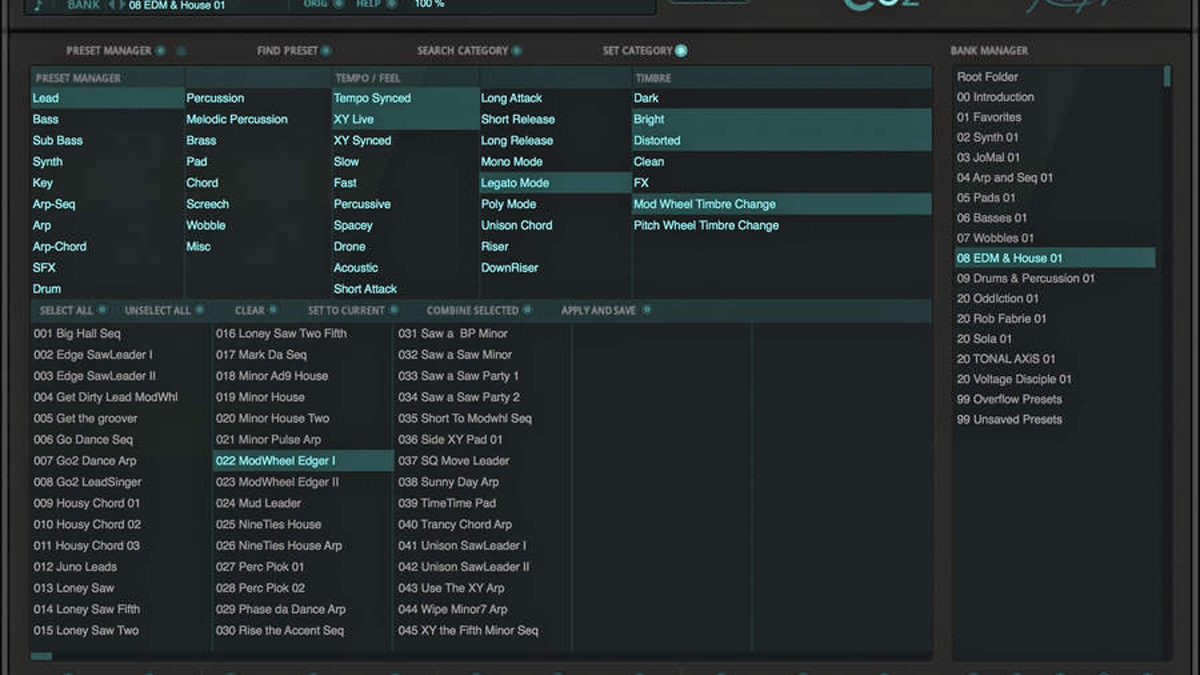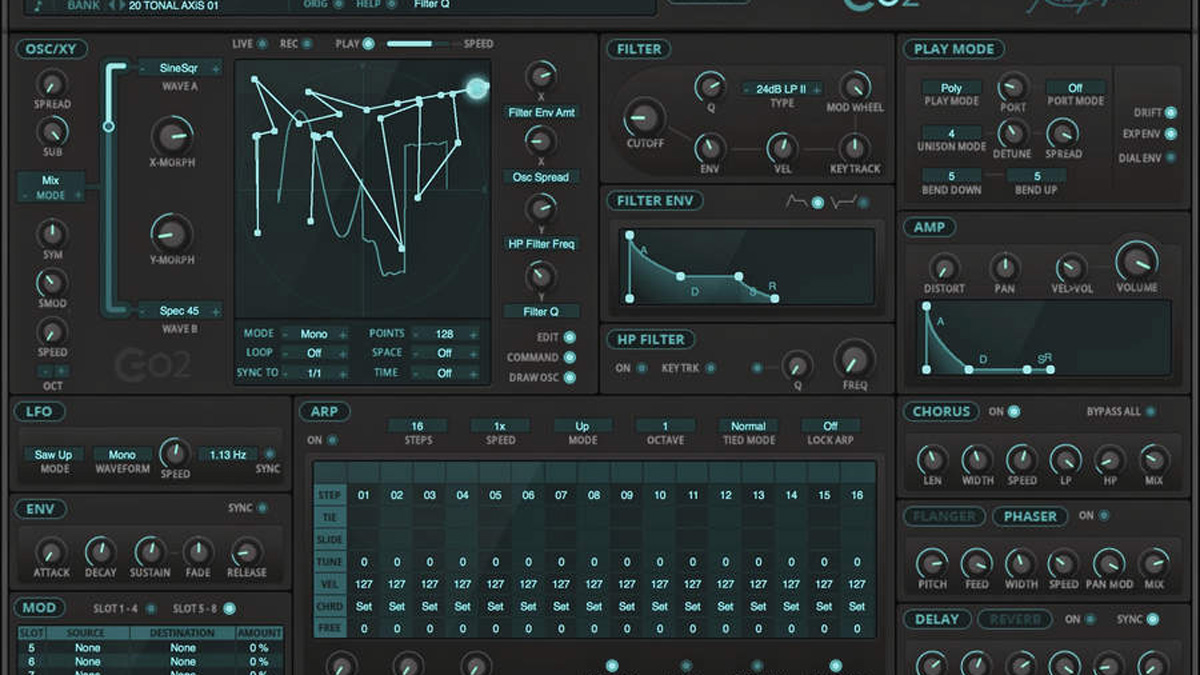MusicRadar Verdict
A slick, powerful, versatile synth with a feature set and sound that belie the price.
Pros
- +
Superb oscillator.
- +
Great sound.
- +
More than 600 presets.
Cons
- -
Parameter modulation isn’t visualized.
MusicRadar's got your back
Filling what sound and synth designer Rob Papen describes as a hole in his line of synths, Go2 places all of its controls in a single window, with almost no pop-outs or tabbed pages to be found (apart from the Preset manager, which fills the whole panel).
This, he says, makes it particularly accessible, although, rightly, he stops short of suggesting that it’s notably easy to use in a ‘beginner-friendly’ sense. You might be able to see all of its controls all the time, and it’s remarkably cheap, but this is still a full-on synthesiser, with no concessions made in the name of simplicity.
On the Go2
Go2 is ostensibly a single-oscillator instrument, but that oscillator is a streamlined version of the one in Rob Papen’s flagship synth, Predator 2, outputting two waveforms at once, chosen from a menu of 128 analogue, additive, spectral and noise options. Using the Spread parameter and pitch modulation, you can tune the two waves away from each other, effectively turning Go2 into a two-oscillator setup.
More interestingly, though, the waves are mixed and morphed in various ways to create hybrid shapes, with the Morph Amount slider positively inviting creative modulation. To that end, Go2’s flagship modulation source, the XY Pad (see X over Y), is located next to the oscillator controls, complete with dedicated X/Y-Morph mod depth knobs, and a real-time oscilloscope for visualising the waveform. Alternatively, Wave A can be deployed as an FM or ring mod source for Wave B, for edgy, clangourous tones.

Further oscillator tweaking is on hand via the Symmetry knob, which stretches/compresses the waveform in either direction from its centre point (ie, pulse width for the square wave), and comes with a dedicated LFO running at up to 55Hz. Additionally, a Sub oscillator an octave down outputs a level-adjustable sine or square wave, just like that in Papen’s SubBoomBass 2.
Up to four spreadable, detunable unison voices are on tap, too. That’s not a particularly impressive number, but it’s partly made up for by Go2’s ability to snap those voices to the notes of an extensive range of chords - Major, Minor, Fifth, Dominant, Diminished, Octaves, etc. Very cool. In terms of fundamental voicing, the synth can be played in Mono, Poly or Legato modes, or Arpeggiated (see below). And for a bit of faux analogue instability, activating the Drift setting introduces pitch fluctuations.
Go2, Go2, Go2!
Go2 has two filters onboard: the first a resonant multimode (LP, BP, Notch, Comb) 12/24dB/ octave job, the second a resonant 12dB/octave high-pass. Alongside Velocity, Keytracking and Mod Wheel mod depth knobs, a graphical ADSR envelope is hardwired to the main filter. This can be literally inverted for negative modulation at the click of a button - a nice touch.
The rest of Go2’s modulation sources comprise Amp and Free envelopes, an LFO (yup, just one here), the Arpeggiator, the XY Pad, all the usual MIDI signals, noise and randomisation. The eight-slot Mod Matrix is split over two four- slot tabs - we’re not sure why it’s OK to break the one-window stricture here, but not in the other sections that we’ll get to shortly. Anyhoo, lonely LFO aside, it’s a good array of modulators, and the list of targets is even more comprehensive, taking in every visible Go2 parameter, including effects controls and modulation depths.
Five effects processors are onboard (plus distortion at the amplifier stage). Chorus is always available, but the tabbed Flanger/Phaser and Delay/Reverb pairings are activated on an either/or basis - ie, you can only use one from each pair at a time. This is particularly problematic with the latter, as reverb and delay are frequently used together in sound design.
Rob Papen’s proprietary XY Pad modulator can be found in several of his synths, but it’s never felt quite as purposeful it does with Go2, where the hardwired X/Y-Morph assignments make clear its intended partnership with the oscillator’s Morph Amount control. As well as those, though, it can also be set to modulate up to four other parameters from throughout the synth - two on each axis - directly from its panel, and as many more as you can fit into the Mod Matrix beyond that.
Switching out of the regular ‘static’ Live mode, the Pad becomes a blank canvas for the creation of elaborate animations. Click the Record button, move the puck around, then hit Play to see your movement magically replayed, one-shot or looping - cyclical or ‘bouncing’ - at a multiplier of your original pace, as determined by the Speed slider (0.06-16x). The path travelled by the puck consists of up to 128 breakpoints, which can be freely dragged around in Edit mode, snapping to note timings and/or an underlying grid if required. Right-clicking the Pad reveals a menu of preset starting path shapes and collective breakpoint modifiers (Flip, Rotate, etc); and triggering of the modulation is switchable between Polyphonic, Monophonic and Free.
We presume this separation has been implemented just to maintain the prevailing single-window concept - a faintly ridiculous scenario, if so. Hopefully a future update will allow us to run all five discretely, but for now, we can at least report that the effects sound ace and offer plenty of control.
Similarly, we guess the 16-step limit on the Arpeggiator/sequencer is down to the reluctance to add an extra tabbed page (for steps 17-32, say). We’re not so bothered by that one, however, as 16 will be enough for most. The Arp covers all the usual bases in terms of arpeggiation directions (Up, Down, Random, Ordered, etc) and sequencing (Tie, Slide, Tune and Velocity lanes), and can be used as a modulation source via the Free or Velocity lanes. Our favourite feature is the Chord lane, in which any from (almost) the same range of chords available to the unison voices is assigned to each step of the sequence. Brilliant!
Good Go2
Go2 effortlessly blasts out the sorts of big, rich, heavily modulated modern sounds in all categories - basses, leads, pads, FX, keys, chords, sequences, etc - for which Papen’s superlative instruments have always been known. Honestly, though, apart from the simultaneous effects issue, we have no real feelings either way about the single window thing - it’s just not something we see as important in the grand scheme of things.
All that matters to us is that Go2 operates smoothly, sounds awesome, and comes in at a fantastic price, all of which it absolutely does. Versatile, intuitive and enjoyable to work with, Papen’s funky new synth could indeed become a go-to instrument for any electronic music producer or sound designer.
Computer Music magazine is the world’s best selling publication dedicated solely to making great music with your Mac or PC computer. Each issue it brings its lucky readers the best in cutting-edge tutorials, need-to-know, expert software reviews and even all the tools you actually need to make great music today, courtesy of our legendary CM Plugin Suite.
Brace yourself: Bryan Adams didn’t buy his first real six-string in a five and dime
“Nobody listens to one genre. I literally don’t know anybody who listens to one genre. You can be a fan of so many different artists at once”: Laufey on what Gen Z can teach the rest of us about how to appreciate music
Bon Iver - ranked: from Sable, Fable to For Emma, Forever Ago











